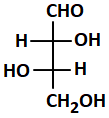Select Chapter Topics:
Which one is not a D-sugar:
1.

2.

3.

4.





Subtopic: Carbohydrates - Classification & D-L configuration |
70%
From NCERT
NEET - 2022
To view explanation, please take trial in the course.
NEET 2025 - Target Batch
Hints
To view explanation, please take trial in the course.
NEET 2025 - Target Batch
Which one of the following is a water-soluble vitamin, that is not excreted easily?
| 1. | Vitamin B2 | 2. | Vitamin B1 |
| 3. | Vitamin B6 | 4. | Vitamin B12 |
Subtopic: Vitamins, Hormones & Enzymes |
88%
From NCERT
Please attempt this question first.
Hints
Please attempt this question first.
Given below are two statements.
In light of the above statements, choose the correct answer from the options given below.
| Assertion (A): | Amylose is a water-insoluble component. |
| Reason (R): | Amylose is a long linear molecule with more than 200 glucose units. |
| 1. | Both (A) and (R) are True and (R) is the correct explanation for (A). |
| 2. | Both (A) and (R) are True but (R) is not the correct explanation for (A). |
| 3. | (A) is True but (R) is False. |
| 4. | (A) is False but (R) is True. |
Subtopic: Polysaccharides & their Importance |
56%
From NCERT
Please attempt this question first.
Hints
Please attempt this question first.
Among the following, a disaccharide is:
1. Fructose
2. Maltose
3. Cellulose
4. Amylopectin
1. Fructose
2. Maltose
3. Cellulose
4. Amylopectin
Subtopic: Carbohydrates - Classification & D-L configuration |
88%
From NCERT
Please attempt this question first.
Hints
Please attempt this question first.
Amylopectin is a branched chain polymer of α-D-glucose having:
| 1. | C1-C4 and C1-C2 glycosidic linkage only. |
| 2. | C1-C6 glycosidic linkage only. |
| 3. | C1-C4 and C1-C6 glycosidic linkage only. |
| 4. | C1-C2 and C1-C6 glycosidic linkage only. |
Subtopic: Polysaccharides & their Importance |
85%
From NCERT
Please attempt this question first.
Hints
Please attempt this question first.
The total number of chiral carbons/centers in \(\beta - D- \) ribose are:
1. Three
2. Four
3. Five
4. Two
1. Three
2. Four
3. Five
4. Two
Subtopic: DNA, RNA & Metal Ions |
61%
From NCERT
Please attempt this question first.
Hints
Please attempt this question first.
Identify the anomeric carbon in the given structure of \(\alpha-D-\) glucopyranose:


| 1. | C1 | 2. | C2 and C3 |
| 3. | C4 and C5 | 4. | C6 |
Subtopic: Carbohydrates - Classification & D-L configuration |
81%
From NCERT
Please attempt this question first.
Hints
Please attempt this question first.
Consider the following statements:
The correct statements are:
1. (a) and (b) only
2. (b) and (c) only
3. (a) and (c) only
4. (a), (b) and (c)
| a. | Glucose is also known as dextrose. |
| b. | Glucose is oxidized to saccharic acid using bromine water. |
| c. | \(\alpha - \text D (+) -\) Glucose contains five chiral centers. |
The correct statements are:
1. (a) and (b) only
2. (b) and (c) only
3. (a) and (c) only
4. (a), (b) and (c)
Subtopic: Carbohydrates - Classification & D-L configuration |
59%
From NCERT
Please attempt this question first.
Hints
Please attempt this question first.
| Statement I: | A unit formed by the attachment of a base to 1' position of sugar is known as a nucleoside. |
| Statement II: | Nucleotides are joined together by phosphodiester linkage between 5' and 3' carbon atoms of the pentose sugar. |
| 1. | Statement I is correct but Statement II is incorrect. |
| 2. | Statement I is incorrect but Statement II is correct. |
| 3. | Both Statement I and Statement II are correct. |
| 4. | Both Statement I and Statement II are incorrect. |
Subtopic: α - Amino Acids, Peptide Bond, Proteins & Structure |
81%
From NCERT
Please attempt this question first.
Hints
Please attempt this question first.
When 10 units of monosaccharides are condensed to form oligosaccharides, the number of water molecules eliminated are:
| 1. | 10 | 2. | 9 |
| 3. | 8 | 4. | 7 |
Subtopic: Polysaccharides & their Importance |
84%
From NCERT
Please attempt this question first.
Hints
Please attempt this question first.






